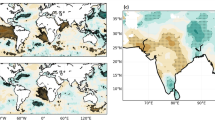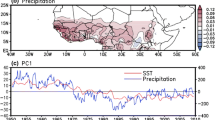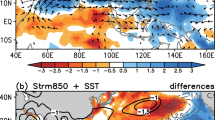Abstract
The summer monsoon inversion in the Arabian Sea is characterized by a large amount of low clouds and August as the peak season. Atmospheric stratification associated with the monsoon inversion has been considered a local system influenced by the advancement of the India–Pakistan monsoon. Empirical and numerical evidence from this study suggests that the Arabian Sea monsoon inversion is linked to a broader-scale monsoon evolution across the African Sahel, South Asia, and East Asia–Western North Pacific (WNP), rather than being a mere byproduct of the India–Pakistan monsoon progression. In August, the upper-tropospheric anticyclone in South Asia extends sideways corresponding with the enhanced precipitation in the subtropical WNP, equatorial Indian Ocean, and African Sahel while the middle part of this anticyclone weakens over the Arabian Sea. The increased heating in the adjacent monsoon systems creates a suppression effect on the Arabian Sea, suggesting an apparent competition among the Africa–Asia–WNP monsoon subsystems. The peak Sahel rainfall in August, together with enhanced heating in the equatorial Indian Ocean, produces a critical effect on strengthening the Arabian Sea thermal inversion. By contrast, the WNP monsoon onset which signifies the eastward expansion of the subtropical Asian monsoon heating might play a secondary or opposite role in the Arabian Sea monsoon inversion.










Similar content being viewed by others
Notes
The strength of the Somali jet is defined as the square root of a kinetic energy of 850-hPa horizontal wind averaged over the region (50°E–70°E, 5°S–20°N), as reported by Boos and Emanuel (2009).
References
Bollasina M, Nigam S (2011) The summertime “heat” low over Pakistan/northwestern India: evolution and origin. Clim Dyn 37:957–970. https://doi.org/10.1007/s00382-010-0879-y
Boos WR, Emanuel KA (2009) Annual intensification of the Somali jet in a quasi-equilibrium framework: observational composites. Q J R Meteorol Soc 135:319–335. https://doi.org/10.1002/qj.388
Caley T, Malaize B, Revel M, Ducassou E, Wainer K, Ibrahim M, Shoeaib D, Migeon S, Marieu V (2011) Orbital timing of the Indian, East Asian and African boreal monsoons and the concept of a ‘global monsoon’. Q Sci Rev 30:3705–3715. https://doi.org/10.1016/j.quascirev.2011.09.015
Chou MD, Wu CH, Kau WS (2011) Large-scale control of summer precipitation in Taiwan. J Clim 24:5081–5093. https://doi.org/10.1175/2011jcli4057.1
Choudhury AD, Krishnan R (2011) Dynamical response of the South Asian monsoon trough to latent heating from stratiform and convective precipitation. J Atmos Sci 68:1347–1363. https://doi.org/10.1175/2011jas3705.1
Desai BN (1967) The Summer Atmospheric Circulation over the Arabian Sea. J Atmos Sci 24:216–220. https://doi.org/10.1175/1520-0469(1967)024<0216:tsacot>2.0.co;2
Ding YH (2007) The variability of the Asian summer monsoon. J Meteorol Soc Jpn 85b:21–54. https://doi.org/10.2151/jmsj.85B.21
Ding YH, Chan JCL (2005) The East Asian summer monsoon: an overview. Meteorol Atmos Phys 89:117–142. https://doi.org/10.1007/s00703-005-0125-z
Dwivedi S, Narayanan MS, Ratnam MV, Rao DN (2016) Characteristics of monsoon inversions over the Arabian Sea observed by satellite sounder and reanalysis data sets. Atmos Chem Phys 16:4497–4509. https://doi.org/10.5194/acp-16-4497-2016
Gadgil S (2003) The Indian monsoon and its variability. Annu Rev Earth Planet Sci 31:429–467. https://doi.org/10.1146/annurev.earth.31.100901.141251
Gadgil S, Vinayachandran PN, Francis PA, Gadgil S (2004) Extremes of the Indian summer monsoon rainfall, ENSO and equatorial Indian Ocean oscillation. Geophys Res Lett. https://doi.org/10.1029/2004gl019733
Gill AE (1980) Some simple solutions for heat-induced tropical circulation. Q J R Meteorol Soc 106:447–462. https://doi.org/10.1256/smsqj.44904
Goswami BN, Krishnamurthy V, Annamalai H (1999) A broad-scale circulation index for the interannual variability of the Indian summer monsoon. Q J R Meteorol Soc 125:611–633. https://doi.org/10.1256/smsqj.55411
Hsu HH, Zhou TJ, Matsumoto J (2014) East Asian, Indochina and Western North Pacific Summer Monsoon—an update. Asia Pacific J Atmos Sci 50:45–68. https://doi.org/10.1007/s13143-014-0027-4
Kamae Y, Ueda H, Kitoh A (2011) Hadley and walker circulations in the mid-pliocene warm period simulated by an atmospheric general circulation model. J Meteorol Soc Jpn 89:475–493. https://doi.org/10.2151/jmsj.2011-505
Kato K (1989) Seasonal transition of the lower-level circulation systems around the Baiu Front in China in 1979 and its relation to the Northern Summer Monsoon. J Meteorol Soc Jpn 67:249–265
Krishnan R, Sugi M (2001) Baiu rainfall variability and associated monsoon teleconnections. J Meteorol Soc Jpn 79:851–860. https://doi.org/10.2151/jmsj.79.851
Krishnan R, Kumar V, Sugi M, Yoshimura J (2009) Internal feedbacks from Monsoon–Midlatitude interactions during droughts in the indian summer monsoon. J Atmos Sci 66:553–578. https://doi.org/10.1175/2008jas2723.1
Kucharski F, Molteni F, Bracco A (2005) Decadal interactions between the western tropical Pacific and the North Atlantic oscillation. Clim Dyn 26:79–91. https://doi.org/10.1007/s00382-005-0085-5
Lander MA (1994) Description of a Monsoon Gyre and its effects on the tropical cyclones in the Western North Pacific during August 1991. Weather Forecast 9:640–654. https://doi.org/10.1175/1520-0434(1994)009<0640:Doamga>2.0.Co;2
LinHo, Wang B (2002) The time–space structure of the Asian–Pacific summer monsoon: a fast annual cycle view. J Clim 15:2001–2019. https://doi.org/10.1175/1520-0442(2002)015<2001:ttssot>2.0.co;2
Matsumoto J (1992) The seasonal-changes in Asian and Australian monsoon regions. J Meteorol Soc Jpn 70:257–273
Matsuno T (1966) Quasi-geostrophic motions in the equatorial area. J Meteorol Soc Jpn Ser II 44:25–43
Molteni F (2003) Atmospheric simulations using a GCM with simplified physical parametrizations. I: model climatology and variability in multi-decadal experiments. Clim Dyn 20:175–191. https://doi.org/10.1007/s00382-002-0268-2
Murakami T, Matsumoto J (1994) Summer monsoon over the Asian continent and Western North Pacific. J Meteorol Soc Jpn 72:719–745
Narayanan MS, Rao BM (1981) Detection of monsoon inversion by Tiros-N satellite. Nature 294:546–548. https://doi.org/10.1038/294546a0
Oort AH, Yienger JJ (1996) Observed interannual variability in the Hadley circulation and its connection to ENSO. J Clim 9:2751–2767. https://doi.org/10.1175/1520-0442(1996)009<2751:Oivith>2.0.Co;2
Priya P, Mujumdar M, Sabin TP, Terray P, Krishnan R (2015) Impacts of Indo-Pacific sea surface temperature anomalies on the summer monsoon circulation and heavy precipitation over Northwest India–Pakistan region during 2010. J Clim 28:3714–3730. https://doi.org/10.1175/jcli-d-14-00595.1
Quan X (2003) Interdecadal change in the Asia–Africa summer monsoon and its associated changes in global atmospheric circulation. Glob Planet Change 37:171–188. https://doi.org/10.1016/s0921-8181(02)00200-x
Ramage CS (1966) The summer atmospheric circulation over the Arabian Sea. J Atmos Sci 23:144–150. https://doi.org/10.1175/1520-0469(1966)023<0144:tsacot>2.0.co;2
Raman CRV, Rao YP (1981) Blocking highs over Asia and monsoon droughts over India. Nature 289:271–273. https://doi.org/10.1038/289271a0
Ramaswamy C (1962) Breaks in the Indian summer monsoon as a phenomenon of interaction between the easterly and the sub-tropical westerly jet streams. Tellus 14:337–349. https://doi.org/10.1111/j.2153-3490.1962.tb01346.x
Rodwell MJ, Hoskins BJ (1996) Monsoons and the dynamics of deserts. Q J R Meteorol Soc 122:1385–1404. https://doi.org/10.1002/qj.49712253408
Rodwell MJ, Hoskins BJ (2001) Subtropical anticyclones and summer monsoons. J Clim 14:3192–3211. https://doi.org/10.1175/1520-0442(2001)014<3192:Saasm>2.0.Co;2
Rossow WB, Schiffer RA (1999) Advances in understanding clouds from ISCCP. Bull Am Meteorol Soc 80:2261–2287. https://doi.org/10.1175/1520-0477(1999)080<2261:Aiucfi>2.0.Co;2
Saeed S, Muller WA, Hagemann S, Jacob D, Mujumdar M, Krishnan R (2011) Precipitation variability over the South Asian monsoon heat low and associated teleconnections. Geophys Res Lett. https://doi.org/10.1029/2011gl046984
Saha K (2011) Some aspects of the Arabian sea summer monsoon. Tellus A. https://doi.org/10.3402/tellusa.v26i4.9852
Saha S, Moorthi S, Pan HL, Wu XR, Wang JD, Nadiga S, Tripp P, Kistler R, Woollen J, Behringer D, Liu HX, Stokes D, Grumbine R, Gayno G, Wang J, Hou YT, Chuang HY, Juang HMH, Sela J, Iredell M, Treadon R, Kleist D, Van Delst P, Keyser D, Derber J, Ek M, Meng J, Wei HL, Yang RQ, Lord S, Van den Dool H, Kumar A, Wang WQ, Long C, Chelliah M, Xue Y, Huang BY, Schemm JK, Ebisuzaki W, Lin R, Xie PP, Chen MY, Zhou ST, Higgins W, Zou CZ, Liu QH, Chen Y, Han Y, Cucurull L, Reynolds RW, Rutledge G, Goldberg M (2010) The Ncep climate forecast system reanalysis. Bull Am Meteor Soc 91:1015–1057. https://doi.org/10.1175/2010bams3001.1
Sampe T, Xie SP (2010) Large-scale dynamics of the Meiyu-Baiu rainband: environmental forcing by the westerly jet. J Clim 23:113–134. https://doi.org/10.1175/2009jcli3128.1
Sathiyamoorthy V, Mahesh C, Gopalan K, Prakash S, Shukla BP, Mathur AK (2013) Characteristics of low clouds over the Arabian Sea. J Geophys Res Atmos 118:13489–13503. https://doi.org/10.1002/2013jd020553
Sun Y, Ding YH, Dai AG (2010) Changing links between South Asian summer monsoon circulation and tropospheric land-sea thermal contrasts under a warming scenario. Geophys Res Lett. https://doi.org/10.1029/2009gl041662
Suzuki S, Hoskins B (2009) The large-scale circulation change at the end of the Baiu season in Japan as seen in ERA40 data. J Meteorol Soc Jpn 87:83–99. https://doi.org/10.2151/jmsj.87.83
Tamura T, Taniguchi K, Koike T (2010) Mechanism of upper tropospheric warming around the Tibetan Plateau at the onset phase of the Asian summer monsoon. J Geophys Res. https://doi.org/10.1029/2008jd011678
Ueda H, Yasunari T (1996) Maturing process of the summer monsoon over the Western North Pacific—a coupled ocean/atmosphere system. J Meteorol Soc Jpn 74:493–508
Ueda H, Ohba M, Xie S-P (2009) Important factors for the development of the Asian–Northwest pacific summer monsoon. J Clim 22:649–669. https://doi.org/10.1175/2008jcli2341.1
Wang S-Y, Gillies RR (2011) Observed change in Sahel rainfall, circulations, African easterly waves, and Atlantic Hurricanes since 1979. Int J Geophys 2011:1–14. https://doi.org/10.1155/2011/259529
Wang SY, Davies RE, Huang WR, Gillies RR (2011) Pakistan’s two-stage monsoon and links with the recent climate change. J Geophys Res Atmos. https://doi.org/10.1029/2011jd015760
Watanabe T, Yamazaki K (2012) Influence of the anticyclonic anomaly in the subtropical jet over the western Tibetan plateau on the intraseasonal variability of the summer asian monsoon in early summer. J Clim 25:1291–1303. https://doi.org/10.1175/Jcli-D-11-00036.1
Webster PJ, Yang S (1992) Monsoon and enso—selectively interactive systems. Q J R Meteorol Soc 118:877–926. https://doi.org/10.1002/qj.49711850705
Wu RG (2002) A mid-latitude Asian circulation anomaly pattern in boreal summer and its connection with the Indian and East Asian summer monsoons. Int J Climatol 22:1879–1895. https://doi.org/10.1002/joc.845
Wu CH, Kau WS, Chou MD (2009) Summer monsoon onset in the subtropical western North Pacific. Geophys Res Lett. https://doi.org/10.1029/2009gl040168
Wu C-H, Chou M-D, Fong Y-H (2017) Impact of the Himalayas on the Meiyu–Baiu migration. Clim Dyn 1–13 https://doi.org/10.1007/s00382-017-3686-x
Acknowledgements
This work was supported by the Consortium for Climate Change Study Phase II (CCliCS-II) under the auspices of the Ministry of Science and Technology (MOST), Taiwan, under grant MOST 105-2119-M-001-018-. CHW was also supported by MOST 105-2119-M-001-021- and 106-2111-M-001-004-. We are grateful for the model SPEEDY from the ICTP and the datasets available from the NCEP, ISCCP, and CloudSat. We also thank the three anonymous reviewers for their constructive comments.
Author information
Authors and Affiliations
Corresponding author
Rights and permissions
About this article
Cite this article
Wu, CH., Wang, SY.S. & Hsu, HH. Large-scale control of the Arabian Sea monsoon inversion in August. Clim Dyn 51, 2581–2592 (2018). https://doi.org/10.1007/s00382-017-4029-7
Received:
Accepted:
Published:
Issue Date:
DOI: https://doi.org/10.1007/s00382-017-4029-7




